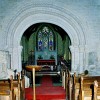Early in the 19th century an invasion of England by Napoleon seemed a distinct and imminent possibility. Along the south east coast, Martello tower defences were constructed as a response to the threat, but although Bonaparte’s grand design fortunately never came to fruition, a legend does abound that the Emperor did not entirely leave John Bull’s hallowed domain untouched.
There is a tradition that during the period of the invasion scares; Napoleon was briefly sighted on the Dorset coast near Lulworth, though Charmouth and Weymouth have also been implicated as possible locations. In modern times the legend was revived again in the 1930’s, when West Lulworth Women’s Institute collaborated on a publication called ‘Dorset Up Along & Down Along.’ In it there is a testimonial related to a member of the branch by a woman who in her youth was a French-speaking farmer’s wife living near the coast, and who claimed to have seen Napoleon walk ashore near Lulworth, roll up a map he had been studying and overheard in conversation the man utter the word “impossible.”
The woman in question, it was later determined, was born in 1784, but because she lived to the age of 104, she was able to tell the Lulworth WI contributor her story. The story goes that at the time of the encounter the witness was assisting her father, a china merchant, in his business and it was through this involvement that the young woman had learnt French. The most likely year of the encounter would have been 1804 when Napoleon was overseeing the assembling of his invasion fleet at embarkation points along the eastern end of the Channel. This period is intensely documented, yet there are a few days when the Emperor’s movements are unknown.
Napoleon was then based at the Chateau of Pont-de-Briques near Boulogne, and so it was thought most likely that the Grand Armee’s objective would have been south east England. Also if the Emperor’s intended landfall was the Dorset coast, it might have been expected that the fleet would have sailed from the Cherbourg peninsula, as this is the point on the French coast facing Dorset.
Certainly the ebb out of Boulogne would have taken the fleet westwards, but then the flood tide along the English coast and the prevailing south-west winds would have tended to drive the fleet back up-Channel. Furthermore, sailing due west from Boulogne would set a fleet on a course for the Isle of Wight, just missing Eastbourne! There was therefore no hope of making landfall at Lulworth with embarkations from Boulogne and other coastal stages in the east. The sandy beaches of Poole Bay would have been easier, but the Grand Armee was no more in a position to beach there either. French intelligence was well acquainted with the defences and conditions of the Dorset coast, since Napoleon regularly dispatched corsairs and spies to capture English fishermen and peasants for interrogation!
But Dorset may have been considered much less risky than the south east coast, which was the target for the two thousand vessels and ten thousand men of Napoleon’s fleet. There is the possibility that a minor diversionary attack was planned for the Purbeck coast, designed to draw the eastern fleet westwards towards Dorset, so leaving the south east coast vulnerable. Indeed, Napoleon was keeping up pressure from Brest for this purpose – a strategy that was not without some success, for in June 1804 King George III told the Duke of York:
“I cannot deny I am rather hurt there is any objection made to forming so large an army of reserves in Dorset where, or in Cornwall, I think an attack more likely than in Essex, Kent or Sussex.”
And later, when approving Dorset’s invasion garrisons and precautions the King asked for more troops to bolster the defence of the county. Certainly the alarm bells were jangling in Dorset as much as elsewhere once the threat from Bonaparte was made manifest.
But the French-speaking farmer’s wife was adamant that Napoleon did go ashore at Lulworth that day in 1804, when she would have been 20 years old. For, like many literate people, she had seen caricatures and cartoons of the Emperor and identified him, she said, by his facial profile and by his cocked hat, though this headwear was by no means unique. Perhaps then, we can see the merchantman’s daughter as unwittingly stumbling upon Bonaparte probably making a brief visit to assess the coastal conditions in preparation for his invasion plans.



